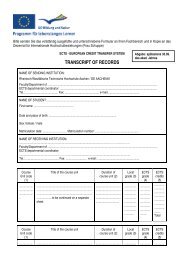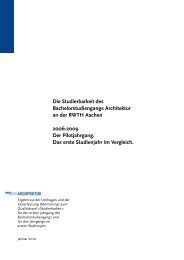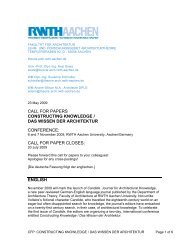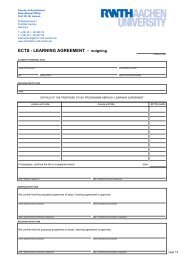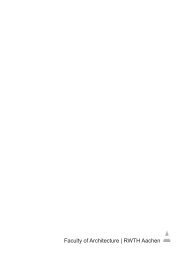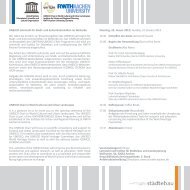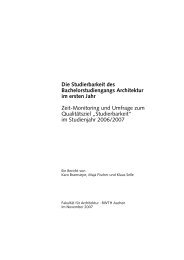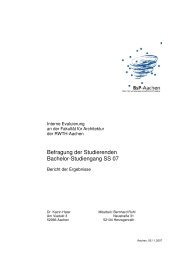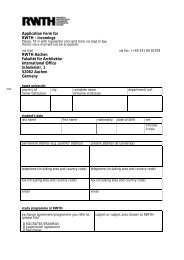Gutachten Dresden_englisch_dritte f.indd - Fakultät für Architektur ...
Gutachten Dresden_englisch_dritte f.indd - Fakultät für Architektur ...
Gutachten Dresden_englisch_dritte f.indd - Fakultät für Architektur ...
Create successful ePaper yourself
Turn your PDF publications into a flip-book with our unique Google optimized e-Paper software.
for the national press when making often rather simplistic reference to the proposed<br />
construction of the Waldschlösschen Bridge, should therefore only be considered as<br />
metaphorical.<br />
In the 18th century, artists explored a new view of the city – from Bautzner Strasse on<br />
the outskirts of town. Travellers from the east came to <strong>Dresden</strong> via this route. At several<br />
points, the forest cleared to reveal a broad panoramic view of the city. Over several<br />
decades, numerous pictures were produced depicting the Elbe valley as seen from<br />
Bautzner Strasse.<br />
In his painting “Prospect von <strong>Dresden</strong> vom Wege nach Bautzen aufgenommen”<br />
(<strong>Dresden</strong>, before 1740), Alexander Thiele presents an especially expansive view of the<br />
river and city, with gently sloping meadows and isolated low trees. From this perspec-<br />
tive the outline of the inner city seems to stretch out across the horizon, and the bends<br />
in the Elbe makes the river appear to be very wide. While Thiele represents the surroun-<br />
ding vegetation very accurately; he also uses it compositionally to embed the <strong>Dresden</strong><br />
city outline in the surrounding landscape.<br />
Approximately 70 years later, around 1810, an anonymous painter depicted the city<br />
of <strong>Dresden</strong> from a similar perspective. The composition of this painting differs to<br />
Thiele’s in that it integrates not only “natural” elements such as the vegetation into the<br />
structure of the painting but also “unnatural” elements such as the twists and turns of<br />
Bautzner Strasse and a series of distinctive, individual buildings across the terrain.<br />
A watercolour by Schinkel, painted after 1803, shows the city more distantly from the<br />
northeast. The two bends in the river, painted in light colours, are at the centre of the<br />
composition. The city outline rising above the wide, light river bend is located in the left<br />
half of this circular painting – at first glance, it is barely discernible. The colours used<br />
and the composition de-emphasise the city to a point where it becomes just one of the<br />
valley’s many features. In Schinkel’s depiction, the city fuses almost completely with the<br />
surrounding landscape.<br />
Franz Wilhelm Leuteritz’s painting shows <strong>Dresden</strong> from “Dinglingers Weinberg”<br />
[Dinglinger’s Vineyard] in the Loschwitz Heights. On the right, the Elbe castles can be<br />
seen in the painting’s foreground. The small, distant city outline is shown above the<br />
broad, low meadow in the Elbe river bend.<br />
From the mid-19th century, the first city panoramas were painted from the perspective<br />
of the Waldschlösschen. This marked the beginning of the renowned Waldschlösschen<br />
view.<br />
49



